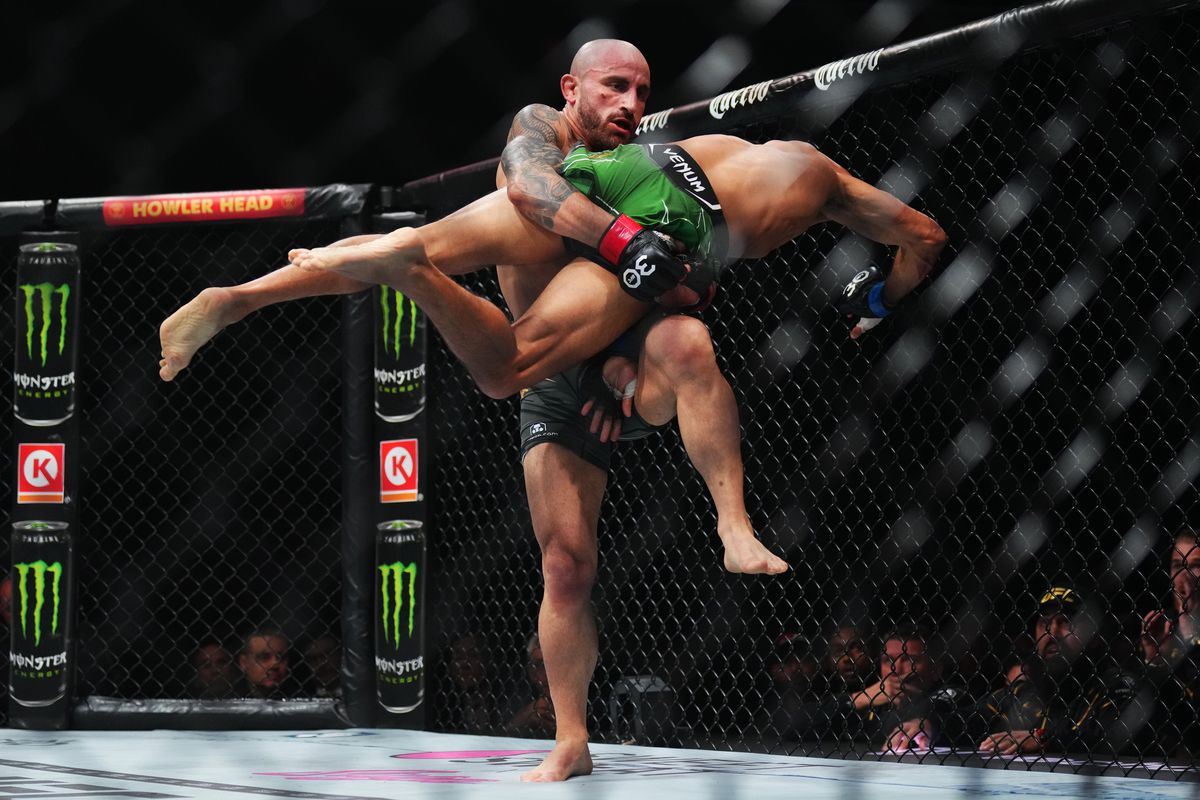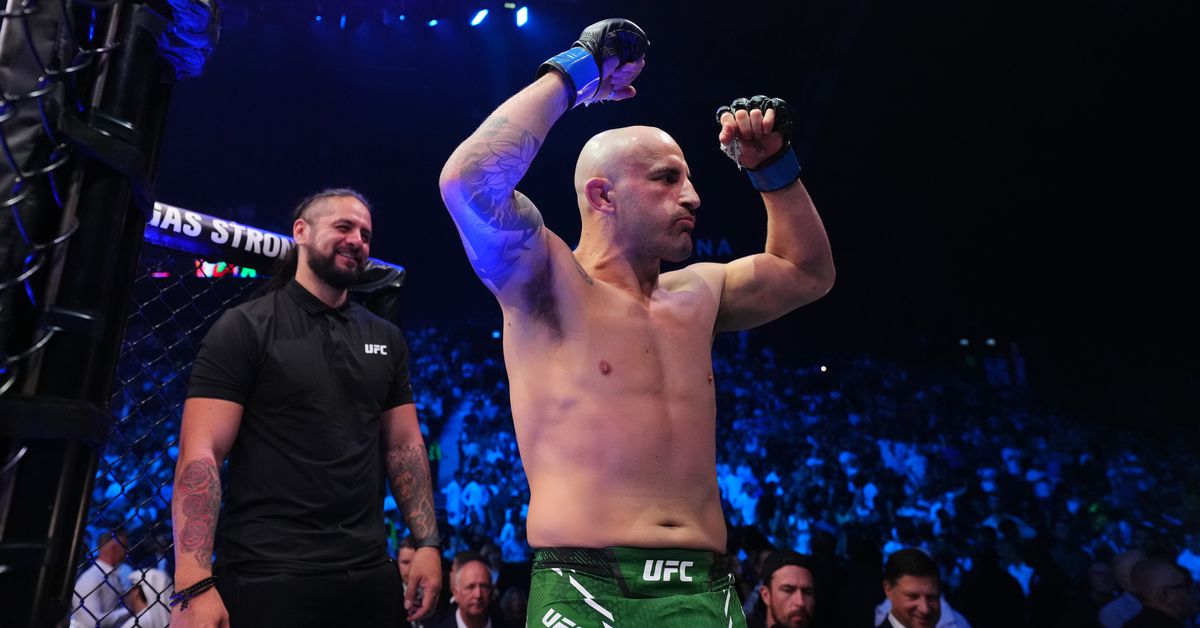Ultimate Fighting Championship (UFC) Featherweight kingpin, Alexander Volkanovski, will go to war with rising star, Ilia Topuria, this Saturday (Feb. 17, 2024) at UFC 298 inside Honda Center in Anaheim, California.
Not that long ago, Volkanovski was voted as the pound-for-pound best fighter alive even after losing a close decision to Islam Makhachev. A good example of how those rankings are supposed to work, as Volkanovski did extraordinarily well while faced with an obvious size advantage. Then, Volkanovski steps up on wildly short-notice to face Makhachev again, predictably gets demolished (watch highlights), and he loses his pound-for-pound crown.
Does anyone think Makhachev beats Leon Edwards with 10 days to prepare? Of course not. Why should that loss mean anything?
The strangeness of Volkanovski’s 2023 combined with the meteoric rise of Topuria (and all his grand statements of greatness) leave us in an odd spot. At 35 years of age — a number that historically spells doom for older champions — Volkanovski is either still the best fighter alive or a lame-duck champion about to get rolled by the next generation.
We won’t find out which until Saturday night, but until then, let’s take a look back at the skills that make him undeniably great:
Striking
Volkanovski began his UFC career as a straightforward (but very good) pressure striker and then developed into a masterful range kickboxer.
Primarily, that change has happened as the competition level rose, as straightforward pushing forward tends to pay fewer dividends against elite opposition. Unlike many pressure fighters, there was a still great deal of craft in how Volkanovski closed the distance. He’s a far better ring cutter than most, inching forward behind active feints and head movement. While forcing the action, Volkanovski keeps his feet beneath him, and he does not present his opponents an easy target.
Volkanovski’s success often begins with his educated lead hand. Early on, Volkanovski will be sticking stiff jabs to the chest and nose of his opponent. Feints are key here, as is the fact that the threat of Volkanovski’s right hand following the jab is very real. Standing one’s ground and trying to counter that jab is a risky proposition at best.
There are several tricks to how Volkanovski sets up the lead hand aside from merely feinting actively. For one, Volkanovski often likes to bring his right shoulder forward, squaring up his chest a bit. Squaring up is often considered a general no-no, but from this position, Volkanovski is presenting his foe the threat of the right hand/hook. Instead, Volkanovski will quickly pull his right shoulder back, allowing him to spear a powerful jab or step up into a left kick (more on that later).
He can also throw the left hook from this position, and Volkanovski will occasionally hook off the jab in general.
The right hand is certainly Volkanovski’s money punch, and again, there’s a lot that goes into creating those big connections. Of course, sometimes it’s as simple as following that jab with a cracking overhand and putting his foe on the canvas.
Often, Volkanovski likes to step through on his right, shifting into Southpaw. This movement has numerous purposes. Most often, Volkanovski likes to step deep into the right — which ensures a majorly powerful punch — with the pursuit of the clinch/shot entry in mind. As his opponent pulls away/blocks the right, Volkanovski secures entry to his takedown opportunities. Against Darren Elkins, Volkanovski landed so hard with this setup several times that Elkins was too busy falling to the mat for his takedown to land!
Alternatively, Volkanovski will step through on the right hand to fire another right hook, this time from Southpaw. This closes a lot of distance, meaning Volkanovski has a good shot at catching his foe circling into the punch. He’ll use the Southpaw shift right hook from his back foot as well, stepping back and throwing simultaneously to counter.
Volkanovski’s crash into the clinch operates as both defense and offense. Firstly, Volkanovski’s opponents are unlikely to catch him clean on the counter if there’s no space to work. Then, Volkanovski just so happens to be excellent at muscling opponents around with the collar-tie, which really helps him land heavy knees and elbows.
Against Islam Makhachev, Volkanovski faced a more severe height and reach disadvantage than usual, and thus he relied on the shifting right hand more than ever before. This resulted in both pros and cons for the Australian. On one hand, some of his best work came off the shift, as he landed the Southpaw right hook well and a couple times cracked Makhachev with a left down the middle afterward. In addition, he did really good work to follow the shift with a low kick as Makhachev circled, which did slow him down over five rounds.
At the same time, Volkanovski grew a little predictably, and his swings a little more wild. Makhachev repeatedly timed him with the counter left hand, as well as standing his ground to clinch and knee. Makhachev doubled down on clinch and knee counter to especially great effect in the rematch.
Too many shorter fighters do not jab or kick because of the range disadvantage, which only serves to widen that gap. Volkanovski, on the other hand, maximizes his range, often with the lead leg round kick. While feinting and showing his back shoulder, Volkanovski is able to quickly lift his lead shin to its target, usually either the liver or inside thigh. It’s a relatively safe strike, one that can pin his opponent in place for a moment and allow Volkanovski to follow up with punches.
The first Max Holloway fight is really Volkanovski’s first distance fighting masterpiece. Opposite the Hawaiian, Volkanovski did not try to pressure much at all. Instead, he attacked Holloway’s stance, picking apart his base and then building from there with layers of offense.
Every stance has pros and cons, and one of the negatives about Holloway’s boxing-orientated, volume-heavy style is that he exposes his lead leg. Holloway has to step forward in order to fire the jab and begin his legendary combinations, and Volkanovski repeatedly attacked that trait.
Sometimes, it was as simple as timing the outside calf kick as Holloway stepped forward. This would off-balance Holloway, allowing Volkanovski to circle off and avoid a prolonged exchange. Other times, Volkanovski would go to the inner leg, offsetting Holloway enough that Volkanovski could effectively punch and clinch.
As Holloway grew more aggressive in response to the low kicks, Volkanovski started setting traps. Often, that trap was an overhand counter lying in wait, but the Aussie also landed his left hook as his right leg returned to stance. In general, Volkanovski does a tremendous job of slipping his head off the center line and letting an overhand fly, but it worked especially well when he knew Holloway was trying to answer the kicks.
Volkanovski faced an even rangier foe in Ortega 2.0, who was coming off a technical showcase win over Chan Sung Jung. Generally, there are two ways to deal with a long and lanky striker. One can pressure him and try to close the gap, or one can give ground, let the opponent reach for him, then land counters.
Volkanovski applied both strategies simultaneously vs. Ortega. Methodically walking him down, Volkanovski landed hard with stiff jabs and right hands, hidden behind lots of feints. Ortega is a naturally aggressive fighter, however, and he wasn’t going to just be backed down. Whenever Ortega did stand his ground, Volkanovski was quick to pull back half a step out of range, then smack Ortega with a jab/overhand or rip into his lead leg.
Finally, Volkanovski’s third win over Holloway was a real masterclass in the jab. After the fight, many fans were really focused on how much faster Volkanovski seemed than Holloway, but that perceived edge in speed can really be traced back to winning the jab battle. Time and time again, Volkanovski was able to initiate with the jab, pull back or move his head, then answer with heavier shots in return.
Often, Volkanovski was beginning and ending combinations with the jab. That’s a really great way to shut down an opponent’s chance at returning fire, as snapping the head back really disrupts any chance of counter shots. All those jabs also served the purpose of disguising the rare flurry, making it more likely that Volkanovski landed when he did surge forward.
The most recent win of Volkanovski’s career came opposite Rodriguez, and the first two rounds were a great throwback to Volkanovski’s early pressure style. He bullied the rangy kicker, pressing him towards the fence with the threat of the right hand then running him over with double legs.
His mauling barrage took a toll on Rodriguez and left him considerable less explosive by the third. All of a sudden, Volkanovski was happy to revert back to his distance striking, dinging Rodriguez on the counter by shifting back from Orthodox into Southpaw with a check right hook. One such blow stunned “Pantera,” leaving him vulnerable to a barrage of ground strikes that finished the contest.
It was very cool to see Volkanovski pressure and counter strike at an elite level, side-by-side in the same fight.

Wrestling
A Greco-Roman wrestler, Volkanovski can hold his own against the best.
“The Great” does his best wrestling along the fence. As mentioned, he’s something of a wood-chipper with his dirty boxing and clinch strikes already, which definitely makes it easier to hide a takedown attempt. Often, Volkanovski has been able to overwhelm opponents with the classic double-leg along the cage, provided they’re feeling the punishment from his close range offense. He was even able to push Makhachev around in the clinch, an impressive accomplishment in its own right.
Really, Volkanovski’s first four UFC bouts followed this similar pattern once the Aussie was able to trap his foes in his cycle of violence. After bullying his foes to the cage, Volkanovski would drop a hard knee or elbow, landed a double, then immediately beat the crap out of his opponent with ground strikes. If they worked back to their feet, the cycle immediately repeated, offering no room for rest.
That grind breaks opponents.
While attacking the clinch, Volkanovski is quite active with the outside trip. He does a really nice job of tangling up the leg and forcing his foe to the mat, but if the trip fails, Volkanovski will just fire off an elbow and shoot again. It’s low-risk for the champion, but the outcome of a single takedown can prove fight-changing.
Against Holloway, Volkanovski’s outside trip failed him. However, when able to secure the body lock, he was twice able to yank Holloway forward then time the inside trip as the Hawaiian tried to pull away. Dropping his head and weight to the side of the trapped leg, the champion managed to gain top control in the extremely competitive fight.
Volkanovski vs. Makhachev proved to be an incredible display of defensive wrestling, even if Makhachev did win multiple rounds thanks to top control — the Dagestani is pretty good on the canvas, after all. Any time Makhachev fully advanced to the body triangle, Volkanovski understandably struggled to escape.
Fortunately, the Australian made his life hell getting there! He did great work in looking to counter Makhachev’s head outside single by attacking the angle and trying to skirt around Makhachev. Often, he did so by attacking the switch, which allowed him to start circling towards the back. Then, he would begin to break his foe’s head position, either with the cross face or simple pressure on the back of the head. Makhachev never let him circle fully, but Volkanovski was able to wrestle out of the crackdown position into a front head lock/stand up multiple times.
If Makhachev did get him down and behind, it still wasn’t over. If “The Great” was near the fence, he would glue his elbow to his hips and stick his back to the cage, trying his best to prevent any hooks. In the open, Volkanovski would instead sit out his hips and turn back into Makhachev, looking to elevate him with either a knee shield or butterfly hook. Several times, he used this strategy to keep the scramble alive and return to his feet.

Brazilian Jiu-Jitsu
Volkanovski has a trio of choke wins on his record, but the most recent came in 2016. Inside the Octagon, the jiu-jitsu brown belt has attempted the guillotine on several occasions versus Elkins.
To his credit, Volkanovski did a great job attacking the neck. He sunk the high-elbow choke deep and secured a good angle on the squeeze. Plus, Elkins was barely conscious when the chokes began. Against almost any other human being, Volkanovski would’ve secured his first UFC tapout, but “The Damage” is insanely tough and especially impossible to guillotine (believe me on this one).
Volkanovski’s submission defense was finally put to the test against Ortega, one of the most opportunistic submission threats on the roster. Three times, Volkanovski was in danger, and three times, he did everything correctly. Let’s break it down!
The first threat was the mounted guillotine, snatched off a caught kick and counter punch. Ortega landed high in mount and with his hands connected around the neck — bad news! Immediately, Volkanovski focused on getting Ortega lower down his body, pushing one hand on the hips and desperately shrimping his own lower body away. Meanwhile, his other hand bought him a bit of blood flow by fighting the choke itself. By freeing his body from Ortega’s leg wrap — and not going unconscious in the process — Volkanovski stopped Ortega from applying hip pressure into the choke, making it survivable.
Next came the triangle, where Volkanovski was pretty much caught in a checkmate vs. a man named “T-City.” In an absolutely desperate move, Volkanovski fell to his side but didn’t entirely give up mount. He essentially forced Ortega to try to finish the choke from between guard and mount, which is just a touch more awkward. Meanwhile, he did his best create space with his arms. If this was the first round, Ortega likely finishes him, but given a bit of fatigue, blood and sweat, Volkanovski was able to free himself and start dropping bombs.
Finally, Volkanovski found himself wrapped up in an anaconda choke. As Ortega tried to gator roll underneath, Volkanovski once again smartly got him stuck in a midway position. Using the fence to his advantage, Volkanovski prevented Ortega from squeezing or advancing position by laying his back on top of Ortega’s chest. Ortega couldn’t free his head, and so he couldn’t keep circling his body toward the choke.
Sometimes, the key to not getting submitted is merely preventing a situation from getting worse and being patient.

Conclusion
Volkanovski is one of the smartest and most well-rounded champions in the history of the sport. If he’s still performing at his best, there are openings in Topuria’s game that the Australian can exploit. However, if he’s lost even half a step, the chance of Topuria just steamrolling him is very real.


